Students Excel at Kula Elementary Science Fair
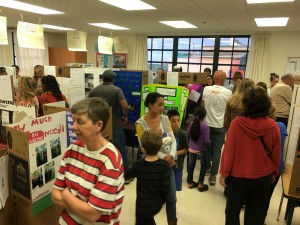
The Kula Elementary School Science Fair was well attended.
The Kula Elementary School Science Fair was the place to be on Thursday night, March 10.
Approximately 100 family members, friends, students and science fans attended the fair to scrutinize scientific methods and the results of experiments conducted by 115 students in grades one through five.
Both the cafeteria and the “stretch” room were packed with display boards representing weeks worth of work on subjects ranging from the complex to the comical.
A wide range of materials was put to use throughout the fair, with creative hypotheses sparking projects and producing an incredible array of results.
For each experiment, the kids used the scientific method. They posed a question, defined a purpose, formed a hypothesis, defined variables, created a procedure, developed a materials list and criteria for measuring “good or bad” results, charted those results and came to a conclusion.
Some of the conclusions agreed with the hypotheses, others… not so much, challenging the young scientists’ ethics, powers of observation and their capacity to remain open-minded in the face of either a happy reality or perceived failure.
Animals were of interest to several young scientists, who mostly focused on man’s best friend.
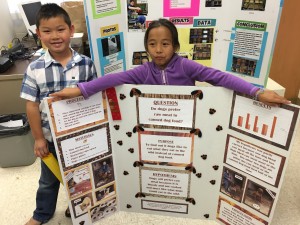
Trey Lu, seen here with an unidentified spokesmodel, concluded that “some dogs will eat anything.” Debra Lordan photo.
Trey Lu’s kick-off question was: Do dogs prefer raw meat or canned dog food? Test subjects: Millie, Daisy, Lehua, Angel and Thunder. Although Trey first asserted that dogs would prefer to eat meat in the form they would find it in the wild, he noted in his conclusion that some dogs don’t seem to have a preference—”they will eat anything.” He received an award for his work. As all credible scientists should, he credited those who assisted him with the project—in his case, his mom.
Chloe Ventura posed this question to kick-start her award-winning experiment that involved her dog, Pono, as the test subject: What dog treat makes a dog’s breath smell the best? Her conclusion? Greenies, she said, “because they are chewy and would get stuck in his teeth.”
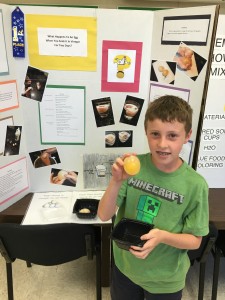
James Notarangelo and his incredible inedible egg. Debra Lordan photo.
James Notarangelo queried: What happens to an egg when you soak it in vinegar for two days? Conclusion: The calcium carbonate egg shell interacts with the acetic acid in vinegar and dissolves. The end result was a semipermeable, rubbery ovoid, aka, an incredible, inedible egg—and a first-place ribbon.
We’ve all heard the expression, “It’s hot enough to fry and egg on the sidewalk.” One young scientist armed with his cast iron pan took to the beach and his driveway to prove that point. However, the pan did not achieve the temperatures necessary to cook an egg, and the experiment turned out to be “a raw deal.”
On to the plant kingdom, a popular subject of experimentation on Maui.
Kick-starter questions included one by Sara Mills: Can plants grow when watered with tap water, Pepsi, salt water and detergent? Visual results showed that salt and detergent were deadly to the bush bean plants. While tap water was the “clear winner,” Pepsi proved to be an adequate growth medium for both beans, ants and mold.
Students also experimented with changing the color of hydrangeas, the effects of music on plant growth, and which fruits and vegetables make the best dyes. (See the slideshow above for details.)
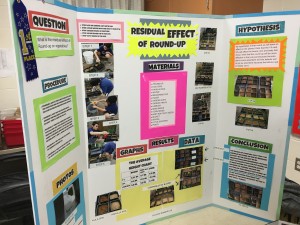
Possibly the most daring topic was studied by Lance Morikawa Jr.—Residual Effects of Roundup. Debra Lordan photo.
Perhaps the most daring topic was presented by Lance Morikawa Jr.—”Residual Effects of Roundup,” Monsanto’s glyphosate-based weed killer. His conclusion: The Roundup company says that Roundup has no residual activity in the soil, but in my observations and research, I noticed that the plants… were either not growing, were growing slowly or turning yellow, or rotting… ” He predicted that a certain percentage of plants would not thrive, and his experiment proved that to be a correct hypothesis.
Natural processes were also on the list of subjects: mainly freezing, melting and molding. Freezing experiments included testing different liquids and freezing different colored water samples to identify which turned to ice the fastest, and leaving raw foods out in the open air to see which grow mold the quickest.
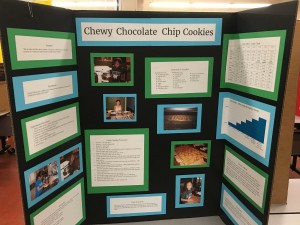
Conclusion: for a chewier chocolate chip cookie, add more vanilla extract, butter and an extra egg yolk, and make sure the batter is very “liquidy” and soft. Debra Lordan photo.
In what could be considered as the “consumer reports” category, students tested tap vs. bottled water, soap vs. sanitizer, a variety of gums and cookie recipes. Conclusion: for a chewier chocolate chip cookie, add more vanilla extract, butter and an extra egg yolk, and make sure the batter is very “liquidy” and soft.
On the other end of the spectrum, Michael Kim was one of the few students to take on statistical analysis with his “Two Dice Experiment.” Below his question, “What are the most common sums of two dice rolled,” he boldly proclaimed, “I guessed 6, but I was wrong!” His results showed that seven was the most common.
Finally, some of the most interesting and advanced experiments came in the form of deconstruction, construction and engineering projects.
Deconstruction of sorts was the basis of a genetics experiment. The student designed an extraction kit using material from “home and Foodland” and used it to purify DNA from strawberries.
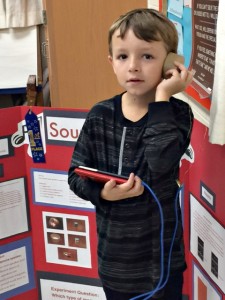
Second-grader Trey Akin, with the help of his parents, built a homemade Sound Box headphone speaker. Photo courtesy Kathy Lordan.
One of the first-place winners at the science fair was second-grader Trey Akin, who, with the help of his parents, built a homemade Sound Box headphone speaker.
Trey and his parents first disassembled a working speaker to identify its components and how they worked.
“I learned a lot by taking apart that speaker—how it works and how sound is created,” said Trey. “It was fun!”
Then the built a mini-model using a small, round cardboard box as the speaker’s cone, copper wire for the electromagnetic coil, connector cables and two types of magnets to try as variables for the permanent magnet. Mom’s iPhone supplied the tunes.
Trey said he thought that using more magnets would make the sound louder, but his results showed that the type of magnet was the more important factor. Neodymium worked best, he said.
“The science fair was really fun and I’m looking forward to doing it again next year,” Trey added.

Natural processes were also on the list of subjects: mainly freezing, melting and molding. Debra Lordan photo.
Kula Elementary School is located at 5000 Kula Highway. Call (808) 876-7610 for more information.
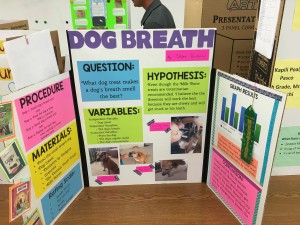
Chloe Ventura posed this question to kick-start her award-winning experiment that involved her dog, Pono, as the test subject.
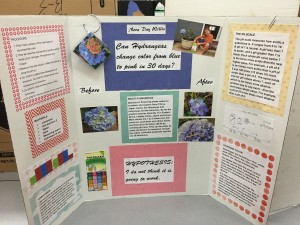
Can the color of hydrangeas be changed in 30 days? Debra Lordan photo.
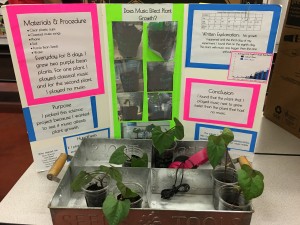
Does music affect plant growth? Debra Lordan photo.
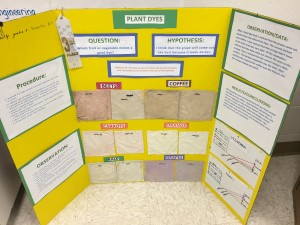
Which fruits and veggies make the best dyes? Debra Lordan photo.
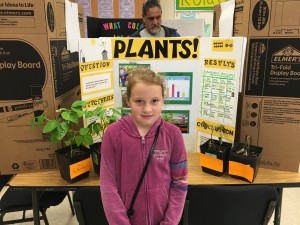
Sara Mills asked, “Can plants grow when watered with tap water, Pepsi, salt water and detergent?” Debra Lordan photo.

Gum experiment. Debra Lordan photo.
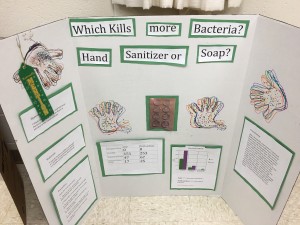
Soap vs. sanitizer. Debra Lordan photo.
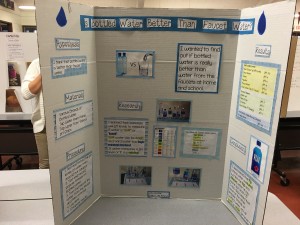
Water taste test. Debra Lordan photo.
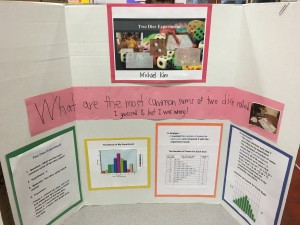
Michael Kim was one of the few students to take on statistical analysis with his “Two Dice Experiment.” Debra Lordan photo.
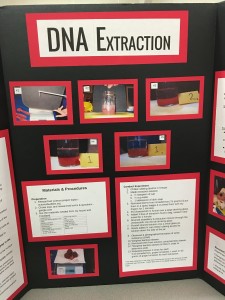
Deconstruction of sorts was the basis of a genetics experiment. The student designed an extraction kit using material from “home and Foodland, and used it to purify DNA from strawberries. Debra Lordan photo.











